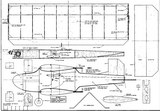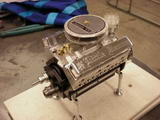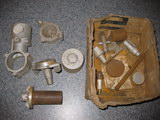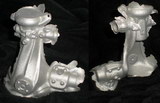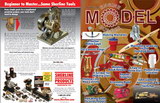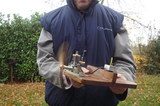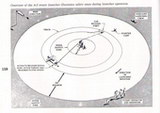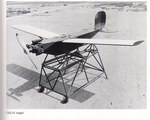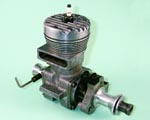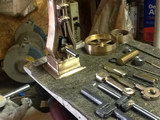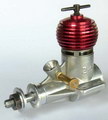Model Engine News: May 2013
Special Features:
 Huck V8 Address Change
Huck V8 Address Change
 Hallum PE
Hallum PE
 Open Crankcase Two-Stroke
Open Crankcase Two-Stroke
 Coles' Power Models Goes 404
Coles' Power Models Goes 404
 MEB #28 On-line
MEB #28 On-line
 Builders' BJ Cicadas
Builders' BJ Cicadas
 New Owen Engines Australia Pricelist
New Owen Engines Australia Pricelist
Regular Features:
 Editorial
Editorial
 New Books and Magazines This Month
New Books and Magazines This Month
 Engine Of The Month: Rowell 60
Engine Of The Month: Rowell 60
 Tech Tip of the Month
Tech Tip of the Month
 Briefly Noted
Briefly Noted
 Standard Stuff
Standard Stuff
|
Unless otherwise expressed, all original text, drawings, and photographs created by Ronald A Chernich appearing on the Model Engine News web site are licensed under a Creative Commons Attribution-Noncommercial-Share Alike 3.0 License. |

|
Editorial
May already. Beats me where the days go. Most of the pains I was experiencing last month went away, so Ruthie and I celebrated by going for a 4km bike ride (push bike, that is). Result? A pulled thigh muscle, and more pain. Feels like I've tuned up the engine to perfection, only to stuff the suspension! Good excuse to lounge around and be waited on, fussed over, and given undeserved sympathy, despite the self-induced nature of the injury.
April is the month in which Ozzies and Kiwis celebrate a World War I defeat (we are a humble, self-effacing people, not at all prone to flaunting our successes, which is just as well). More seriously, it is a day to remember our fallen in all wars. The "defeat" anniversary is the landing on April 25, 1915 of the Australian and New Zealand Army Corps (now known as the ANZACs) on the Gallipoli peninsula in order to open the Dardanelles to the allied navies. This failed rather badly, but recent research suggests this was not totally the fault of the British leadership of the forces. All a bit academic after all this time really, but the day is taken more seriously than a lot of other Australian public holidays I could mention, such as the Queen's Birthday Weekend.
The weather is turning at last, so before it gets too cold to do anything in our unheated workshops, my old flying buddy and I decided to embark an a massive building campaign. In our old high school days, we could start a model on Friday night, and fly it Sunday morning, generally with the paint still wet. Giving due allowance for advancing years, we decided that between the two of us, we should be able to build and fly a "fun" type control line model in two weeks. We will consider it a failure if the grass does not stick to it on the first outing. We've chosen a twenty year old design from Flying Models, called a Bi-Slob. It's simple, boxy, ugly, and supposed to be capable of the Walker "Saber Dance", which neither of us is, but perhaps it's never too late. If we succeed, you'll see the photos here next month. If we don't we'll keep quiet and hope you forget...
Huck V8 Address Change
How about that? A news item title which is actually descriptive and unambiguous, for a change. Steve Huck emailed to notify of a change in his email contact details. To refresh your memory, have a look back to the July 2011 Edition, and the Demon V8, designed by Steve, from whom you can get the full and very complete plan set, right down to the spark plugs! Steve has provided a series of articles on building the engine which you can access via the Model Engineering Web. Steve also contributed an article on making cams to thie web site, which you'll find in our How-To Index. Oh yes, his new email address is [email protected]. For completeness, the email address in our 2011 news item has been changed accordingly..
Hallum PE
The Hallum Company, of Poole, Dorset (UK), is one of the forgotten pioneers of British model engines. Their designs span the nineteen-forties, with displacements between 2.5 and 13.5cc, including a 5cc in-line twin, and a 2.5cc diesel. All were piston ported (aka "side-port") and with the exception of the lonely 1947 2.5cc diesel, all were spark ignition. Although Hallum did sell assembled engines, the majority were sold as kits, so considerable variation exists in examples seen today. One unusual feature which appeared on at least three different Hallum models, was the lack of crankcase engine lugs. Instead, "ears" were cast onto the sides of the backplate and front bearing housing for mounting purposes. This always seems a bit on the fragile side to me, and certainly Hallum produced many designs with more conventional mounting lugs. All this is a lead-in to the latest engine from Jan Huning (who provided us with the Westbury Atom Minor Mk III construction series). Jan was presented with a genuine Hallum kit and has done it justice in the best possible way. Click the thumbnail, or follow the link to the Hallum 9.5cc Petrol Engine page.
Open Crankcase Two-Stroke
As we all should know, the vast majority of model (and full-size) two-stroke internal combustion engines use what we term "crankcase charging". That is to say, the changing crankcase volume is used as a pump to transfer the air and fuel mixture to the cylinder. There have been a number of "open crankcase" model engines, but nearly all are four-strokes, that have a manifold to deliver the air-fuel mix to the inlet valve, which is generally located in the cylinder head. There has been, to my knowledge, at least one model two-stroke where the crankpin end of the crankshaft, and the connecting rod, were exposed to the atmosphere. Well better make that two, as a new design by Nick Rowland offers people a chance to watch some of the spinning and reciprocating bits in all their glory.
Cynics may say it's easy to build a 3D model of something in a computer, but quite another to turn that into physical reality. Well Nick got a whole lot closer this month with the first casting for his rather artistic design being delivered. This is the raw casting which has some flash around the parting line, but Nick says it is thin and uniform, so the casting will clean up easily. I'm sure this is one engine which we are all keen to see the internal details of, and one that we all want to see completed and running, so "watch this space"...
Coles' Power Models Goes 404
We are still trying for confirmation on this one, but it appears that Coles' Power Models (TX, USA) may be no more. This is sad as they were a significant supplier of fittings for American live steam builders, and the last remaining source of castings for the designs of Elmer Wall. We are trying to find out more, but their web site has ceased to exist, so it's not looking good.
MEB #28 On-line
The second all-electric edition of Model Engine Builder was posted for download during April. Subscribers will have received an email announcing its availability, and the download instructions. Mike and Toni Rehmus have prepared three separate downloads for their magazine, all as portable data format (pdf) files, zipped up to optimize the download. The first is the traditional magazine page format, ready for printing to US Letter size paper. Next is "tabloid" format (double Letter size). This provides a wrap-around cover image (seen here), the "centerfold" picture, and all the drawings. If you are concerned about download time, you might want to skip this one as everything here is also included in the Letter size download—just a bit smaller in the case of the drawings. Finally, there's a size optimized for on-screen viewing, which I found very easy on the eye. Content wise, Issue #28 is loaded with good stuff, including an in-line twin version of the Humbug some bloke called Ron Chernich designed. #28 also continues Mike's very detailed build of the standard, one-lung Humbug showing Yet Another way to knurl prop drivers.
I know some readers were apprehensive about the change from traditional print magazine to an on-line model. I think this issue shows MEB has found its feet in the new format and I hope all model engine builder consider subscribing, if they have not already.
Builders' BJ Cicadas
This has taken longer than it should: a home page for the BJ Cicada diesel, which was our Christmas 2012 Free Plan. As with the BollAero 18 Home Page, the new BJ Cicada Home Page will feature plans built engines from around the world, and we kick it off with belated thanks to Gerard Bleekman (NL) who constructed one of the prototype engines. His BJ Cicada was completed in November 2012 and is easily able to turn an 8x6 prop, although performance is better on props in the 7" range. If you have a Cicada running, or under construction, send in your photos and we'll add them to the page.
New Books and Magazines This Month
A query from a reader during the past month made me reach for my copy of Dennymites, Drones, & More, by James Dunkin. In another of those coincidences that suggests everything is interconnected, last month's Engine of the Month made mention of Norma Jean, as does Jim's Dennymite book. This jogged my memory to recall that reading the References section of that book for the review had prompted me to track down a copy of an out of print book about drones, and that I'd subsequently almost forgotten about it! So better late than never we have...
50 Years of Target Drone Aircraft, by Richard A Botzum,Northrop Corporation, 1985, (no ISBN). This is a hard back book of 168 pages with numerous black and white photographs and illustrations, which details the remote controlled target drones, first conceived and built by the "Radioplane Co", with engines designed and built by Walter H Righter (got to get that Elton John track out of my head, somehow). Radioplane became a division of Northrop Aviation in 1952, eventually becoming the Northrop Ventura Division some time in the mid 1970's. Botzum says he initially started out to present a technical profile of the drone aircraft produced by the three companies, but was convinced by the company vice president to expand it to include the people behind the 'planes. It makes for a fascinating story of pioneering design and development—all the more relevant today as unmanned aerial vehicles (UAV for short) become all the rage in the news, entertainment media, and the military.
While the advances from the Denny Radioplane to today's UAV's (and the UACV's under development) are as staggering as the development of aviation itself during the same period, I find myself more astounded at just how far the slightly over-grown radio controlled model 'planes produced by Radioplane in the 1940's and 1950's were ahead of what the recognized pioneers of radio control model planes were accomplishing in the same period. That they were doing it using super-regen receivers with "bang-bang" controls, operated by servicemen with little training is even more impressive. The book's timeline begins in 1935 and ends in 1985, when it was published. The almost thirty years since has seen even more radical developments, especially in the areas of autonomous control, but again, we learn from the book that Radioplane OQ-19B was fitted with an "out-of-sight" autopilot as early as 1950.
Jim Duncan's book focused on the early Radioplane engines, and the man behind those engines. Richard Botzum concentrates more on the airframes and control systems, although powerplants get good coverage too, as do the various launching systems devised over the years. No control line modeler could help but grin at this "rotary" launch system from the 1950's, the operation of which should need no further words.
It is worth noting that the basic control system devised by Reginald Denny and Kenneth Chase persisted for a long time. As mentioned earlier, the receiver was of the super-regenerative variety. Basically, this is an oscillator on the brink of bursting into life, which would do so on reception of a wiff of electromagnetic radiation of approximately the right frequency. Naturally, you could only have one receiver operating within the range of the transmitter at any one time. The transmitter could be modulated by five different audio tones. Four drove the rudder and elevator servos, left-right, up-down. These were all or nothing. There was no proportional control; if the operator wanted less than full up, the technique was to "blip" the button and nudge the drone into the direction required. The fifth tone was transmitted continuously. If it was lost, either by being turned off, or the drone flying out of range, or suffering an electronics failure, a relay would release, the engine would stop, and the recovery parachute would deploy. A "fail-safe" system way, way before the modeling world managed to incorporate such devices. It is well worth noting that the OQ-14 drone of 1944 seen here is basically, the OQ-3 of 1943, which was Radioplane's first really successful product. Over 5,000 OQ-14's were produced and used to train gunnery crews during World War II.
The books contains some absolute anecdotal gems, including a translation table of American to British English terms, for example, cord (US) = string (Brit), and no, it does not appear to be tongue in cheek! I'll finish up quoting one from the Prolog. You may recall that General Billy Mitchell became extremely unpopular over his demonstrations between 1921 and 1923 when he sank or damaged a number of old World War I battleships by aerial bombardment. His detractors liked to point out that as the ships were unmanned, they could not defend themselves.
In an attempt to at least partially resolve the questions raised by Mitchell's tests, the British Air Ministry in October 1930 requested the Royal Aircraft Establishment (RAE) to produce a radio-controlled target aircraft that could be used to simulate attacks on Royal Navy ships.
Three Fairey IIIF floatplanes were modified into target aircraft by the RAE in 1930-31 by installing radio equipment and increasing wing dihedral to 10 degrees. Successful manned test flights with the newly modified "Fairey Queens" were conducted in the autumn of 1931. In January and April of 1932, unmanned tests were conducted which resulted in the crashes of two target aircraft soon after their being catapulted from HMS Valiant. In September 1932, the third aircraft enjoyed a successful nine-minute, radio-controlled flight. This remaining target was launched again in January 1933 when it was flown against the concentrated gunfire of the Home Fleet during an exercise in the Mediterranean. For two hours, every gun in the fleet tried in vain to destroy the lone, slow, and fragile target, but it was recovered safely. The British Admiralty had learned a valuable lesson.
I enjoyed the Drone book, although I suspect a lot of my enjoyment comes from having lived through the early years of model radio-control, with super-regen receivers and bang-bang controls—we called it free-flight with occasional radio interference. I'm amazed that the Radioplane Company accomplished so much, with so little, well before the modeling world enjoyed anywhere near the same level of success. All that said, the book left me wanting more detail as it tends to tantalize as much as it informs. However it makes a nice companion to the Dennyplane book for those interested in the early history of Drones and you can locate copies at prices between reasonable and outrageous here, on Amazon. I'll rate it as four stars  .
.
Engine Of The Month: Rowell
In case it has escaped your notice, Adrian Duncan has slowly but surly been researching and reporting on all of the Big Iron racing engines from the late 1940's and early 1950's. Last month we had the Dooling 60, and before that we had the Bungay, the Nordec, the Conqueror, and the MVVS. This month, Adrian looks in depth at the Rowell (say what?), another McCoy inspired British racing 60 which is perhaps better known in the land and water circles than it is in the control line circles. As usual, Adrian has dug up more on this engine that has ever been printed anywhere before, period. And guess what? He 'aint finished yet—but we are going not going to tell you what is in the pipeline; just be assured it is a story worth waiting for.
Tech Tip of the Month
I always get a buzz out of emails from Model Engineers who have found a trick, or a technique somewhere in these pages which has helped them, especially when it results in returning an old model engine to active service, and double buzz when it's a diesel (ahh... the smell of ether in the morning...). Here we see a composite photo of an old, forged FROG 150 conrod (right in each pair), and the replacement, made using the techniques described in Conrids Made Easy. The rod for a 1.5cc engine is not large, and, as noted in the article, one can understandably become a tad apprehensive about placing one's delicate pink bits so close to a milling cutter. OH&S might well be appalled, but with due care and concentration, the results are excellent.
Another reader used our description of the various ways you can machine crankshafts (which he termed The Idiot's Guide to Crankshaft Turning  ) to machine a full shaft for his coke-bottle stationary engine. He ran into only one snag—one which by coincidence, I encountered on a similar full crank once—on the last operation, the shaft got bumped by the compound slide, when "bing", and a second one was made (after a pause for strong prayer). This is so easy to do that I've finally conditioned myself to give the lathe chuck a turn by hand each time before turning on the power. I'm positively embarrassed by the number of times this simple precaution has saved me from disaster (and will probably continue to do so, based on past performance). Things like bolts securing something to the faceplate striking the bed, or positioned so they'd strike the toolpost when it was brought up.
) to machine a full shaft for his coke-bottle stationary engine. He ran into only one snag—one which by coincidence, I encountered on a similar full crank once—on the last operation, the shaft got bumped by the compound slide, when "bing", and a second one was made (after a pause for strong prayer). This is so easy to do that I've finally conditioned myself to give the lathe chuck a turn by hand each time before turning on the power. I'm positively embarrassed by the number of times this simple precaution has saved me from disaster (and will probably continue to do so, based on past performance). Things like bolts securing something to the faceplate striking the bed, or positioned so they'd strike the toolpost when it was brought up.
I call it a good habit to get into, and further caution that if your lathe spindle is, like mine, threaded, rotate the chuck backwards while performing this check as you don't want to unintentionally loosen the chuck by rotating it forward. Why? Look back to out February 2004 Tech Tip. One of Guy Latuard's Machinists' Bedside Reader series of books contains a similar story, except in that case, the chuck backplate had to be machined off the lathe spindle (and a replacement made before the boss returned the next day). It helps to keep your spindle nose and lathe backplate threads immaculately clean, and well oiled too, but the best cure is awareness of the potential danger, and not being in a rush!
New Owen Engines Australia Pricelist
Owen Engines Australia has released a new price schedule which lists the excellent little MP Jet range of engines, the PAW range, and David Owen's own Taipan 2.5 replica, which has been approved by the MAAA for use in the Gordon Burford R/C event. T2.5s placed 1st and 3rd in the recent Easter SAM 35sec engine run championship event. These engines are better than the originals and in very limited supply, so even if you act NOW, there's no guarantee you'll be able to score one, which at AU$220.00 for a hand build engine is more than reasonable. Click the T2.5 image for the OEA May 2013 Price List
Briefly Noted
This section is intended to alert you to little things that are hard to expand to a full news item, or cunningly wind into the Editorial, but are worthy of note never the less.
- Somehow, the March 2013 Members' Free Plan got left out of the Plans Index.
- The script which generates the New and Updated Index has, ahem, been getting it wrong since January this year. Fixed now.

